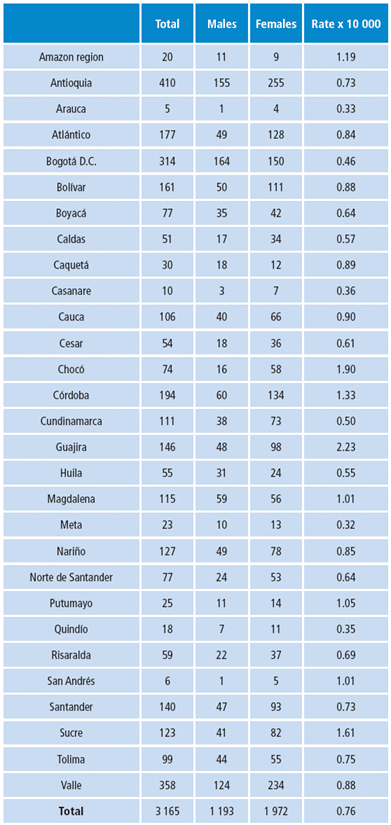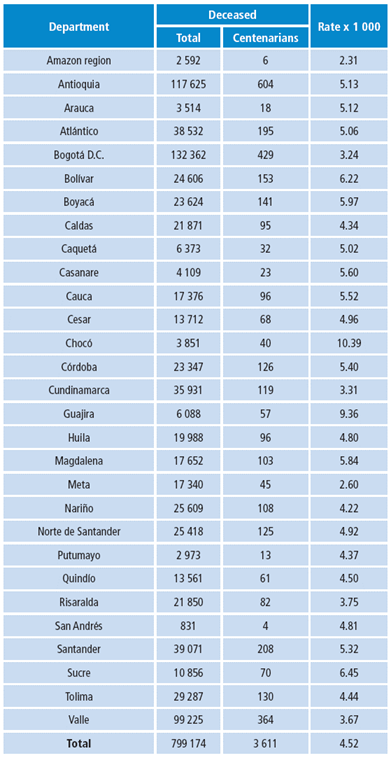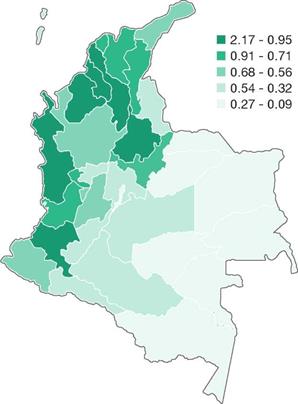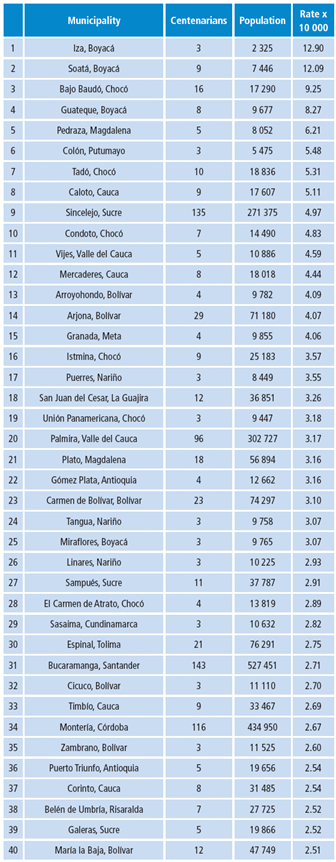Introduction
Centenarians are individuals aged 100 years or older. This is a group of interest to geriatricians, demographers and epidemiologists concerned with the aging process 1-3. In Colombia, research on this age group is scarce, and its geographical distribution as well as other sociodemographic and clinical characteristics have not been analyzed. The only published Colombian study characterized 29 centenarian patients who consulted the emergency department of a university hospital in Bogotá during an eight-year period 4.
Current registration methods, particularly RIPS (which are completed every time a user of any of the health systems in Colombia has access to a health service), could help determining the number of centenarians in the country, their distribution by gender, the places where they live, and the types of diseases they suffer.
This paper describes the information collected from RIPS, together with the data obtained in the last national census of 2005 and the ages recorded in the death certificates that the National Administrative Department of Statistics (DANE in Spanish) records and summarizes every year.
Materials and methods
A descriptive study to review the information on centennial population was conducted in three different databases. First, data obtained from the 2005 census, referring to the population aged 100 or older and their characterization by gender and departmental distribution, were examined on the DANE webpage. Based on this census population, a rate was estimated for every 10 000 inhabitants per department that year.
Second, based on the DANE webpage as well, the data of centenarians who died between 2010 and 2013 were collected. At first, including data for 2014 was considered, but it was finally discarded since it had not been consolidated by the time this research was conducted. Subsequently, the number of deceased centenarians was correlated to the total number of deaths in the same departments during that period. This result was expressed in number of centenarians for every 1 000 deceased.
The third analysis was based on RIPS. These records were created in 2000 by the ]Ministry of Health to evaluate and monitor the Colombian health system and to support public health decisions. Although doubts about the quality of information are always mentioned, RIPS have been used in different fields of research, including a study of the economic impact of aging Colombian population 5. Information regarding the site of the query, gender and age could be considered reliable to some extent; even though RIPS records have missing and inconsistent data, with these records, it is possible to locate centenarians and determine their most common diagnoses.
Results
Census 2005
According to the 2005 national census, there were 50 077 people over 80 (213 734 men and 287 343 women) in Colombia, which is equivalent to 1.17% of the population. Out of this group of seniors, 3 165 were 100 years or older, 1 193 men and 1 972 women (62.3%). Given that the national population was 41 468 384 (20 336 117 men and 21 132 267 women) at the time, the national centenarian rate for 2005 was 0.76 per 10 000 Colombians (0.59 for men and 0.93 for women).
As Table 1 demonstrates, the rate of centenarians per 10 000 inhabitants presented a minimum value in Meta (0.32), Arauca (0.33), Quindío (0.35), and Casanare (0.36), while the highest values were recorded in La Guajira (2.23), Chocó (1.9), Sucre (1.61), and Córdoba (1.33). In the census, people were classified into ethnic groups. Thus, among those self-defined as indigenous, there were 73 255 over 60 years of age, of whom 467 (0.64%) were over 100. In the Afro-descendants group, 227 598 were over 60 and 1 425 were over 100 (0.63%). Furthermore, other groups had 3 190 262 people over 60 years, and 2 409 of them were over 100 years of age (0.08%).
Table 1 Geographical distribution of centenarians according to the 2005 census and rate per 10 000 inhabitants of each department.

Source: Own elaboration based on 6.
Death Certificates 2010-2013
During this four-year period, 799 174 death certificates were issued in Colombia (200 524 in 2010, 195 823 in 2011, 199 756 in 2012 and 203 071 in 2013). 3 611 of them were for centenarians (832 in 2010, 857 in 2011, 897 in 2012 and 1 025 in 2013), of which 66.2% were equivalent to 2 390 women. The rate of centenarians per 1 000 deaths in that period was 4.52 (4.15 in 2010, 4.38 in 2011, 4.49 in 2012 and 5.05 in 2013).
Table 2 shows the total number of deaths and the respective proportion of centenarians per 1 000 deaths, per department. The highest values were observed in Chocó (10.4 per 1 000), La Guajira (9.4), Sucre (6.5) and Bolívar (6.2). The lowest rates were found in the Amazon region (which includes the Amazonas, Guainía, Guaviare, Vaupés and Vichada departments) with 2.3, and Meta with 2.6.
Table 2 Total deaths per department in the 2010-2013 period, and proportion of centenarians per thousand deaths.

Source: Own elaboration based on 7.
RIPS 2014
According to RIPS, 3 390 people aged between 100 and 109 years were attended in Colombia, of which 2 154 (63.5%) were women. Based on these records, the number of individuals is reduced every additional year, so that there are 1 270 people aged 100, 818 aged 101, 578 aged 102, and so on until having only 67 aged 109 (Figure 1).

Source: Own elaboration based on tne data obtained in the study.
Figure 1 Centenarian population pyramid in Colombia according to RIPS 2014.
If the official population projections issued by DANE, which are based on the 2005 census, are taken as the denominator, there were about 47 661 787 inhabitants that year in Colombia, which means that for every 10 000 Colombians, there would be 0.71 centenarians. Most of these patients were attended in Bogotá (528), Antioquia (433), Valle del Cauca (410), Bolívar (222) and Santander (219). After adjusting the departmental population, however, the departments with the highest rates were Sucre with 183 (2.17 per 10 000), Chocó with 64 (1.29 per 10 000), Córdoba with 187 (1.11 per 10 000) and Bolívar and Santander (both with 1.07 per 10 000) (Table 3).
Table 3 Number of centenarians registered in RIPS 2014. Population according to DANE estimates and centenarian rate per 10 000 inhabitants, having DANE projections for that year as denominator.

Source: Own elaboration based on the data obtained in the study.
In the entire Caribbean Region, the centenarian population was 1 039, which is a somewhat higher proportion (1.01 per 10 000) than in the rest of the country, where the centenarian rate decreases (0.63 per 10 000) if the Caribbean Region is excluded. On the other hand, the departments with the lowest rates of centenarians were Guaviare with 2 (0.2 per 10 000 inhabitants), Vichada with 1 (0.14 per 10 000) and Casanare with 3 (0.09 per 10 000). The map shows the rates of centenarians by department (Figure 2).

Source: Own elaboration based on data obtained in the study.
Figure 2 Rate of centenarians per 10 000 inhabitants in Colombia, according to RIPS 2014.
Finally, Table 4 presents the list of the 40 Colombian municipalities with rates higher than 2.5 centenarians per 10 000 inhabitants. These include six municipalities of Chocó, six of Bolivar, four of Boyacá and four of Cauca. The capital city with the highest proportion of centenarians was Sincelejo, but Bucaramanga and Monteria also appeared on the top of the list.
Table 4 Colombian municipalities with the highest rate of centenarians according to RIPS 2014 (only those with three people older than 100 years or more were included). The population corresponds to the municipal projections of DANE for that year.

Sourse: Own elaboration based on the data obtained in the study.
Discussion
The results of this study showed, through three different sources of information, a similar pattern of the number and distribution of centenarians in Colombia. In terms of numbers, the 2005 census identified 3 165 centenarians, while the 2014 RIPS found 3 390 (corresponding to an annual growth rate of 0.8%).
Furthermore, considering that 3 611 people aged 100 years or more died between 2010 and 2013, and estimating the death rate of Japanese centenarians aged between 100 and 104 years at 30% per year (35% for men and 27% for women) 8, it could be estimated that the average centenarian population for that period in Colombia was 3 009 people.
However, a common bias could be inherent in these records because of the process of obtaining the citizenship card and the date registered as birth date, which was the basis for age determination in the three databases. These official national citizen identification date back to 1952 9, when current centenarians were around 30 years. It is possible that the age of birth, especially in the rural areas of Colombia, was imprecise, as was the case of the Ecuadorian population from Vilcabamba 10.
Moreover, there are methods to validate the age of people, as tested in Japanese 8, Chinese 11 and Caucasian 12 populations. These include interviews with relatives to confirm the birth dates, the age at marriage, and the birth date of children and grandchildren 13.
Even with these limitations, it is interesting to note the presence of a significant number of elderly people in some of the poorest areas of the country, such as Chocó and some departments of the Caribbean region. Certain characteristics of these inhabitants may be equated to those described in the so-called blue zones, which are sites of relatively large long-lived populations 14, such as Okinawa in Japan, Sardinia in Italy, Ikaria in Greece, Loma Linda in California, and the Nicoya peninsula in Costa Rica. Some of the characteristics described in these areas include a traditional lifestyle, intense physical activity even in seniors, reduced levels of stress, high family and community support, and consumption of locally produced foods 15,16.
On the other hand, Colombia has no global indicators of healthy living by departments. Alcohol consumption represented by sales of alcohol in annual liters per capita has a national average of 4.15, which somewhat decreases in the departments of interest. Thus, in La Guajira, the average was 1.64, in Chocó 2.01, in Córdoba 3.20, and in Sucre 3.28 17. However, these values do not consider the impact of contraband.
Regarding cigarette consumption, according to statistics from the Ministry of Health, in 2007, 3 of these 4 departments may have had a prevalence of tobacco consumption below the national average (12.8%), except for Chocó, which registered 15.9%. The other departments showed a prevalence of 7.8 in La Guajira, 10.5 in Córdoba and 11.9 in Sucre 18.
The 2005 census data allowed estimating life expectancy at birth in Colombia for the five-year period 2000-2005, with an average value for men and women equivalent to 72.8 years. This represented an increase of 2.5 years in relation to the previous 15 years. Some departments with high rates of centenarians, despite having a life expectancy at birth below the national average, showed higher increases when comparing the five-year period 1985-1990 to 20002005. Chocó was first with 5.4 years (going from 60.1 to 65.5), followed by Córdoba with 4.8 (from 65.8 to 70.6), and Sucre with 4.7 (from 67.0 to 71.7) 19.
By performing secondary analyzes of official databases (two from DANE and one from the Ministry of Health), this study intended to draw interest on the centenarian population in Colombia, and to continue with this the study, through other strategies, to know if there are regions in the country where longevity tends to concentrate.














